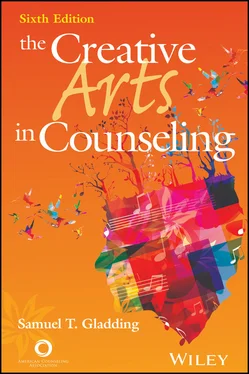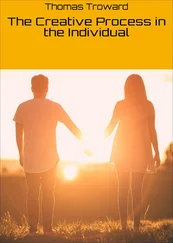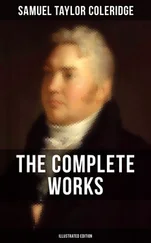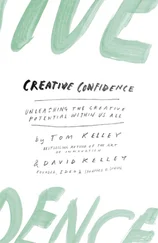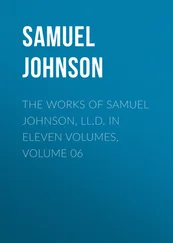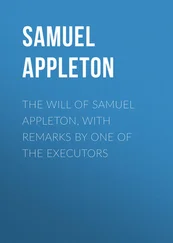Samuel T. Gladding - The Creative Arts in Counseling
Здесь есть возможность читать онлайн «Samuel T. Gladding - The Creative Arts in Counseling» — ознакомительный отрывок электронной книги совершенно бесплатно, а после прочтения отрывка купить полную версию. В некоторых случаях можно слушать аудио, скачать через торрент в формате fb2 и присутствует краткое содержание. Жанр: unrecognised, на английском языке. Описание произведения, (предисловие) а так же отзывы посетителей доступны на портале библиотеки ЛибКат.
- Название:The Creative Arts in Counseling
- Автор:
- Жанр:
- Год:неизвестен
- ISBN:нет данных
- Рейтинг книги:3 / 5. Голосов: 1
-
Избранное:Добавить в избранное
- Отзывы:
-
Ваша оценка:
- 60
- 1
- 2
- 3
- 4
- 5
The Creative Arts in Counseling: краткое содержание, описание и аннотация
Предлагаем к чтению аннотацию, описание, краткое содержание или предисловие (зависит от того, что написал сам автор книги «The Creative Arts in Counseling»). Если вы не нашли необходимую информацию о книге — напишите в комментариях, мы постараемся отыскать её.
*To purchase print copies, please visit the ACA website here
*Reproduction requests for material from books published by ACA should be directed to permissions@counseling.org
The Creative Arts in Counseling — читать онлайн ознакомительный отрывок
Ниже представлен текст книги, разбитый по страницам. Система сохранения места последней прочитанной страницы, позволяет с удобством читать онлайн бесплатно книгу «The Creative Arts in Counseling», без необходимости каждый раз заново искать на чём Вы остановились. Поставьте закладку, и сможете в любой момент перейти на страницу, на которой закончили чтение.
Интервал:
Закладка:
In composition, children are encouraged not only to write but also to sing their songs. Mayers (1995) advised, “It is not necessary to teach the child to engage in this activity, only to direct the songwriting toward a therapeutic end. Children are capable of determining what they need, what words will be calming, what tune fits the mood” (p. 497). Through composing and writing their own songs, children learn to be more independent as well as creative. They also learn to be less anxious and feel a sense of empowerment. Mayers reported that children as young as 4 and 5 years old can compose songs that are helpful to them in dealing with their situations.
Music is used with children in other therapeutic ways as well. For example, Hodas (1993) created a music tape titled Stretch Yourself? Songs for Coping that contains a variety of selections counselors can use with children who are having difficulty dealing with different forms of adversity. The song selections encompass a wide variety of topics, including sexual abuse, physical illness, suicide, the effects of war, and gender issues. Memory (2002) likewise chose to use music with at-risk children and teens. In dealing with special child populations, songs must be chosen with care. A well-chosen song can be quite powerful in helping children recognize situations and deal with them appropriately and constructively. Another way of breaking through children’s shells of isolation therapeutically with music is by playing sounds familiar to them, such as internal body sounds (e.g., a stomach growling or a heart beating), or having them listen to neighborhood sounds. Once rapport is established in this manner, rhythmic activities and rhythm instruments such as sticks and tambourines can be used to engage these children and gradually draw them into social relationships with other children and adults.
Adolescents
Music is popular with adolescents, and almost all listen to music as well as incorporate it into their lives (Kimbel & Protivnak, 2010). This means of self-expression and emotional release plays a role in adolescent development in multiple ways (Armstrong & Ricard, 2016). Young people almost invariably describe the positive benefits of engaging with music when asked to reflect on the relationship between music and health (McFerran & Saarikallio, 2014). Music is a particularly powerful source of social communication and social influence in this age group (Ostlund & Kinnier, 1997). Community music therapy can provide an authentic relationship-building experience for college students (Schwantes & Rivera, 2017). At its best, music can be lifesaving, such as the lyrics of “How to Save a Life” by The Fray. Music can also increase prosocial behavior; for example, preventing HIV (Thompson, 2003). At its worst, music may become repetitive and stale or glorify violent behavior, which may increase negative emotions and thoughts that can lead to aggression (A. Palmer, 2003). Popular music is both a reflection of and an exacerbating influence on attitudes, values, and behaviors (Bushong, 2002).
Creative Reflection
What were your favorite musical groups when you were a teenager? How did their music affect you? What messages did you get from it? How is it similar to and different from the music adolescents listen to now?
Most adolescents are deeply involved in music, such as playing a musical instrument, playing in a band, going to concerts, or identifying with major musical figures (Kimbel & Protivnak, 2010). For some, music is quite inspirational because it evokes “images of movies . . . in which movie characters triumphed over adversities” (Gfeller, 1988, p. 41). The fact that the website Spotify ( www.spotify.com/us/) and its offspring are largely listened to by an audience younger than 30 years of age (and even the existence of such channels is known only to them) is further evidence of the importance of music in the lives of this age group. In addition, television shows like The Voice , American Idol , and America’s Got Talent and games such as Guitar Hero and Dance Dance Revolution focus on music and appeal to this age group. Overall, the activities and events just mentioned plus the rhythm and words of Lil Wayne, Rihanna, Lady A, Black Eyed Peas, Drake, Tim McGraw, Ke$ha, and Lady Gaga speak to adolescent youth in unique and powerful ways.
For young adolescents, according to Wells (1988), “music therapy is helpful in bridging the gap between nonverbal and talking therapy. It aids in mastery and sublimation of thoughts and feelings, and it helps to facilitate ego development through success-oriented experiences” (p. 47). For older adolescents, participating in music therapy activities gives them a firsthand experience of the relationship between effort made and skill achieved in music performance. Adolescents in juvenile delinquency programs benefit from music therapy activities because they become increasingly aware of the connectedness between hard work and achievement. Their self-esteem and self-expression may increase as well, with a substantial decrease in hostility and disruptive behaviors (Rio & Tenney, 2002). Teens may also realize that playing a socially desirable musical instrument such as the piano or guitar increases their acceptance among peers.
In addition, adolescents are often interested in song writing and may wish to express themselves lyrically (Cheesebrow, 2018). A song is generally considered to be a poem set to music. To foster a preventive and therapeutic process, music therapists and counselors skilled in music can work with adolescents using a number of song-writing techniques, “including changing the words to familiar songs, filling in the blanks of edited familiar songs, vocal improvisation, adding new verses to known songs, parodying familiar songs, and using natural rhythms of speech as a starting point” (Goldstein, 1990, p. 119). Counselors who are musicians themselves may also use original music they have written to help adolescents explore difficult areas such as gender issues and sexuality (Hodas, 1991). In addition, school counselors and counselors who work with adolescents in other settings can use musical interventions such as listening to music and sharing and using music in psychoeducational activities.
One interesting use of music in counseling at-risk youth—in particular, inner-city Black and Latinx adolescents—is transforming rap music into rap therapy (Armstrong & Ricard, 2016). Rap therapy (Elligan, 2004) is rooted in social learning theory and a cognitive behavioral model. Through it, “clients become aware of the association between personal lyric interpretation, their emotions, and at-risk behaviors. This awareness aids in their ability to be reflective and allows them to effectively problem solve” (T. Gonzalez & Hayes, 2009, p. 162). Like in other counseling approaches, assessment is completed and rapport is established before any attempts at change take place. However, once these two stages of counseling are complete, clinicians work to help broaden clients’ appreciation of types of rap other than those that dominate their lives and then, through written exercises, role-play lyrics as well as engage clients to create and interpret their own lyrics. Finally, clients are encouraged to move into positive actions that are maintained through modeling and reinforcement.
Adults
In addition to being therapeutic for adolescents, rap therapy is beneficial for adults. For instance, Hakvoort (2015) found several benefits using rap in therapy to reduce anxiety and to improve emotional regulation and impulsivity with an incarcerated population diagnosed with various psychiatric or psychological disorders. Likewise, in a limited qualitative study using person-centered groups of prisoners, A. Richards et al. (2019) found that when elements of rap music were integrated into the therapeutic process, participants self-reported reduced feelings of anxiety, more autonomy, a great sense of identity, a strong connection to others, and improved happiness. Creating a beat to represent their emotions and experiences made it easier for many participants to speak as well as connect with and feel heard by others.
Читать дальшеИнтервал:
Закладка:
Похожие книги на «The Creative Arts in Counseling»
Представляем Вашему вниманию похожие книги на «The Creative Arts in Counseling» списком для выбора. Мы отобрали схожую по названию и смыслу литературу в надежде предоставить читателям больше вариантов отыскать новые, интересные, ещё непрочитанные произведения.
Обсуждение, отзывы о книге «The Creative Arts in Counseling» и просто собственные мнения читателей. Оставьте ваши комментарии, напишите, что Вы думаете о произведении, его смысле или главных героях. Укажите что конкретно понравилось, а что нет, и почему Вы так считаете.
